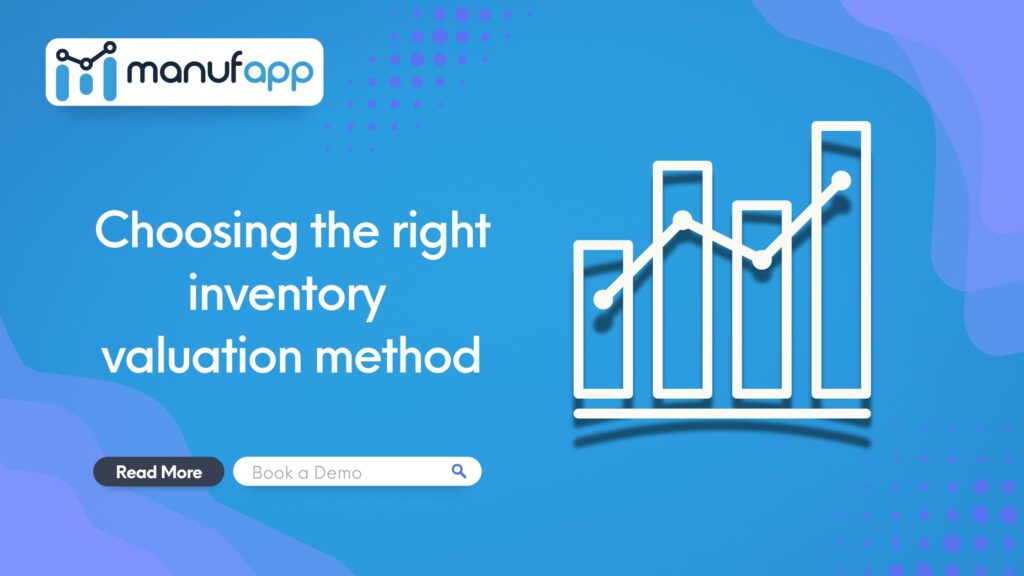INTRODUCTION:
Choosing the right inventory valuation method is crucial for any manufacturing entity as it helps in accurately reporting and maintaining financial performance, managing costs and implementing strategies specific to the inventory costing. Each method has advantages and disadvantages, and the best choice depends on several factors specific to your business. The most basic factor required to understand is the nature of the business i.e., whether the company deals in homogeneous or heterogeneous items.
HOW TO SELECT THE MOST APPROPRIATE INVENTORY COSTING METHOD?
As discussed in the previous blog on “Inventory Costing Methods for Manufacturers”, the most appropriate Inventory Valuation Method can be selected by understanding the nature of the business. Like the Specific Identification method works only for companies dealing in heterogeneous/ unique and high-value items which can be easily identified. FIFO, LIFO or Weighted Average Cost methods can be used for companies dealing in homogeneous items.
Furthermore, companies that deal with items that have a shorter shelf life and tend to become obsolete after a specific period are advised to use FIFO (First-In, First- Out) method as the items brought in first are sold first. FIFO is also ideal in times of inflation, when prices are rising, inventory valuation through FIFO can result in lower COGS since the oldest/ cheaper inventory items are sold first and the value of ending inventory is high, which generates a higher gross profit and therefore a higher tax liability.
Whereas, the LIFO (Last-in, First-Out) method sells the latest inventory first, making it best for businesses that want to reflect the current cost of goods sold. Companies using the LIFO method for the valuation of their inventory can obtain certain tax benefits in times of inflation. As per the LIFO method, the latest/most expensive items are sold first, which means the COGS is higher and the value of Ending Inventory is lower since the remaining goods are those which were brought when prices were less comparatively. This results in the company earning a lower gross profit and thus reduces a company’s taxable income. Therefore, companies using the LIFO method tend to pay a lower tax liability, especially during inflation.
The Weighted Average Cost method smoothens out the cost fluctuations and provides an average cost for inventory items. With the Weighted Average Cost method, it is easier to achieve uniformity in inventory valuation as it uses an average cost to calculate values for COGS and Ending Inventory. In the case of FIFO, it tends to produce higher gross profit, and LIFO produces lower gross profit, Weighted Average Cost produces gross profit something between FIFO and LIFO. Consequently, FIFO generates a high tax bill and LIFO a lower tax bill, with Weighted Average Cost again something in the middle, this method therefore simplifies record keeping.
WAYS TO REDUCE INVENTORY COSTS:
Reducing inventory costs is crucial for any manufacturing entity to improve its profitability and cash flow. Effective inventory management strategies can be used to reduce holding and ordering costs while also ensuring that customer demand is met timely. Some techniques to minimize inventory costs are:
- Implement Just-In-Time (JIT) Inventory: JIT helps in minimizing the amount of inventory in hand by ordering for inventory just when required. This reduces storage costs, and obsolescence and prevents capital from being unnecessarily tied up in inventory. Establishing and maintaining strong relations with suppliers to ensure timely delivery of raw materials which prevents the need to stock excess inventory.
- Optimize Inventory Levels: Use the ABC Analysis method to classify inventory items into three categories- A, B and C. This helps the company to focus on optimizing high-value inventory items (A) while also managing other inventory items of lower value (B and C). Using the Economic Order Quantity (EOQ) method helps to calculate the optimal order quantity which reduces the need to order again and again i.e. minimizing ordering costs.
- Enhance Demand Forecasting: Use forecasting techniques to correctly analyse the upcoming and ongoing market trends and understand demand precisely. Working with the sales and marketing teams to incorporate promotional activities and market conditions into demand forecasts.
- Use Inventory Management Software: Implementing inventory management software that automates tracking, ordering and reporting processes. This software helps to monitor inventory levels and identify obsolete and waste resources by utilizing real-time data. They also suggest how much inventory is required to be ordered so that waste generation is prevented. Companies nowadays use inventory management software to properly segregate perishable and non-perishable items, thereby maximizing efficiency in business operations. Inventory management software provides technological support to a company and reduces errors which can be made while manually entering and tracking inventory.
CONCLUSION:
Inventory Costing is of great significance for manufacturers and businesses as it impacts financial reporting, tax liabilities and cost management strategies which are crucial for any company’s existence. An understanding of the different inventory costing methods- FIFO, LIFO, Weighted Average, and Specific Identification, complemented by using effective inventory management strategies is essential for meeting a business’s specific requirements. Businesses should evaluate their inventory costing methods and management practices from time to time to ensure proper alignment with the ever-changing market conditions and must ensure that customer demands are met regularly.





